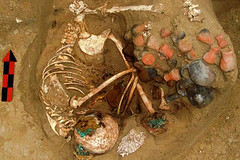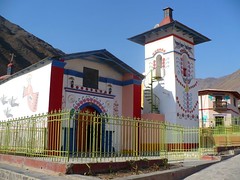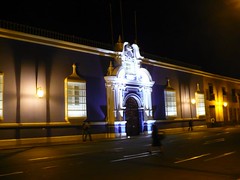Poachers return to the southern Andes killing thousands of vicuñas
The silent massacres continue as fur poachers return to the southern Andes. Without mercy they kill and skin the endangered animals for their fur to smuggle to Argentina for sale on international markets. Lack of government protection of wilderness reserves leave locals without help.
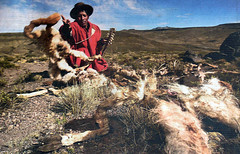
Local shows victims to photographer Dante Piaggo
The number of massacres carried out against these rare and beautiful animals have been on the increase in the past five years. Almost driven to extinction by more than 400 years of unrestricted hunting since the Spanish conquest, Peru undertook a massive drive in the 60s to protect their numbers and allow their population to recover. Severe penalties faced anyone caught killing a vicuña while rural populations were allowed to sheer the animals to sell for a living thus removing an incentive for illegal hunts.
Despite this, illegal criminal gangs continue to operate. Between 1995 and 2004 as many as 6,740 of the camelids were slaughtered – although a decrease from the tens of thousands in the decades before, illegal hunting is beginning to increase.
The cause of this has been the deactivation of the system of protection set up in the 60s by a more recent negligent government. While a decade ago a number of wardens protected vicuña populations by seeing off poachers, today no such protection exists and gangs are free to roam the Andes killing as they please.
Jorge Herrera Hidalgo, ex-president of the Lima region’s vicuña breeding association and also ex-regional president of the now non-existent CONACS program that protected the animals affirms that is due to the shutting down of the group’s activities that this alarming spike in killings is taking place.
“Along with heavy bureaucracy that does nothing to help rural communities, this has caused a dramatic decrease in the populations of vicuñas in Lima and Apurímac, for example, where the 30-40% of the population has been slaughtered. Of the 17,689 animals that existed in the region of Lima in 2000, it is feared the population is now around 10,000”, he explains. Of course, there is no way of knowing for sure because his organisation has been shut down. It could be much worse than this.
Terrorised locals
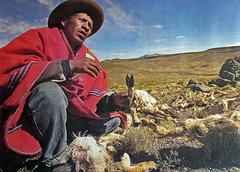
Remains of Vicuñas
“They come with guns to our homes”, explains old man Leandro Qquesa Ccala of the community of Negro Mayo in Lucanas on the edge of the regions of Ayacucho and Apurímac, “they bring with them rice and pasta and tell us to cook it for them. We can’t say no because they threaten us with their weapons. They disappear and return a couple of days later. They sometimes leave us a carcass of a vicuña before going off to other places to search for more vicuñas.”
He explains that this year the hunts have been more sporadic, but in years past the poachers had an almost permanent presence. He explains that this is because the government ended the self-protection programs that existed before. He wants them reactivated.
As does Cosme Huamaní Chipana, lieutenant governor of the community of San Miguel de Mestizo, in Cotaruse, Aymaraes-Apurímac. He was almost killed by the criminal gangs who he witnessed kill no less than 30 vicuñas.
“I was returning to San Miguel when I stumbled across the poachers. At gunpoint, they forced me to knell down, they stole the little coca, corn and cheese that I had. They were about to murder me when a farmer was seen approaching in the distance. One of them stopped the one who was preparing to kill me”, he recalls.
Rather than kill him, he removed his sandals and made him march barefoot for 4 hours on the frigid Andean topsoil carrying the pelts from the vicuñas they had slaughtered before setting him free.
It is tales like this that cause you to wonder how many more slaughters have taken place that locals who aren’t as brave as Cosme have not had the courage to report to authorities, if there are any authorities to report to.
Juan Barazorda Cabrera is president of the National Association of Park Rangers of Peru, a group founded last year in the face of disinterest of the central government.
“These past nine years, and after all this shutting down of CONACS and the system of vicuña defence, we have heard that many communities, because of fear of the criminal gangs, no longer protect the animals or report their massacres for fear of reprisals. Tired of political inertia, their abandonment by government and the lack of legal institutions to punish the criminals, the vicuña has ceased to be a natural resource for them or a symbol of national heritage”, he explains, continuing that he hopes his organisation can begin to reverse the damage.
Worth its weight in gold
Vicuña fur is extremely popular for its warmth and softness. The strands of fur are hollow and interlocking allowing it trap and insulate air. The finest fur in the world, it can sell on international markets for as much as $800 per kilo. A simple scarf can cost upwards of $1500 and a men’s suit more than $20,000.
Tags: alpaca, apurimac, argentina, campesinos, CONACS, crime, park rangers, poachers, vicuñas


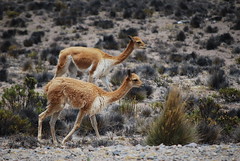

![Peru celebrates Independence Day with fountain of booze [Featured]](http://farm4.static.flickr.com/3236/2697186491_f7a74ae0da_m.jpg)


